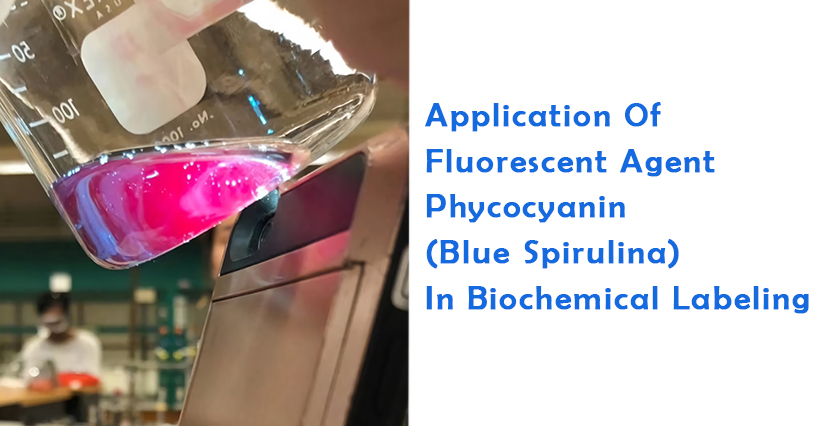
Application Of Fluorescent Agent Phycocyanin(Blue Spirulina) In Biochemical Labeling
The phycocyanin(blue spirulina) is strongly fluorescent, emitting orange-red fluorescence, while phycocyanin itself is blue. Compared with traditional fluorescent probes, phycobiliprotein fluorescent probes have a smaller fluorescent background, are not easily quenched and are beneficial to the selection of excitation light, and greatly improve the sensitivity of fluorescence detection.
The Phycocyanin(blue spirulina) is strongly fluorescent, emitting orange-red fluorescence, while it is blue in color.
Phycobiliprotein is a series of novel fluorescent labeling probes with excellent fluorescence properties. Labeling antibodies with phycobiliprotein fluorescent probes can also be used for fluorescent immunoassay of serum soluble antigens (or antibodies). The labeling methods can be divided into direct method and indirect methods. It is a new type of fluorescent probe, which has been applied in the fields of immunohistochemistry and fluorescence immunoassay. Therefore, the study of phycobiliprotein series fluorescent probes and their labeling methods are great significance for phycobiliprotein fluorescent probes development and utilization.
FIA, which uses a fluorescent indicator label as a probe, is a long-established marker immunoassay that chemically binding a fluorescent dye-labeled antibody (or antigen) to a corresponding antigen (or antibody) in a tissue or cell, checks antigens or antibodies qualitatively or locating. It not only has a wide range of uses in the diagnosis of infectious diseases, but also can be used to identify lymphocyte subsets if combined with monoclonal antibodies, and can automatically detect cell size and fluorescence intensity by flow cytometer (FACS).

Phycobiliprotein Fluorescence Characteristics
For immunofluorescence analysis, phycobiliprotein fluorescent probes have superior advantages over traditional fluorescent dyes:
1) highly soluble in an aqueous environment, the effect of non-specific binding is small. The isoelectric points of various phycobiliproteins are in the range of pH 4.7 ~ 5.3, in the conditions of physiological pH value, phycobiliprotein and the cell surface is negatively charged, and its non-specific binding is less.
2) The fluorescence emitted will not be spontaneously quenched by other biological substances.
3) The absorbance and fluorescence quantum yield of phycobiliprotein is high, and it is independent of the environment pH value, which is beneficial to improve the sensitivity.
4) The fluorescence excitation and emission of phycobiliproteins have a large displacement of STOKES, but according to the principle of energy transfer, special techniques can be used to construct the intermolecular crosslinks of two phycobiliproteins or the combination of phycobiliproteins and other fluorescent dyes. This can make its STOKES shift more widely, and the emitted fluorescence is closer to the red end of the visible spectrum, which reduces and eliminates the interference of sample background fluorescence, Raman scattering, and Rayleigh scattering.
5) Phycobiliprotein is easy to bind with other molecules, forming a variety of cross-linking bodies that can be excited by single excitation light in the visible region, emitting different colors of fluorescence. They can be used as two-color, three-color, and other multi-color markers respectively marked different monoclonal antibody, and can achieve simultaneous determination of multiple components. The absorption spectrum and fluorescence spectrum of phycobiliprotein are almost constant in the range of pH 4-11, and the absorption spectrum and fluorescence spectrum will not be changed when combined with the monoclonal antibody.
Compared with traditional fluorescent probes, phycobiliprotein fluorescent probes have a smaller fluorescent background, are not easily quenched, and are beneficial to the selection of excitation light, which greatly improves the sensitivity of fluorescence detection. In addition, the phycobiliprotein fluorescent probe has a great feature for immunoassay, that is, the fluorescence preservation period is longer. When detecting serum soluble antigen, we use the R-phycoerythrin probe as a fluorescent marker for the positive sample, the fluorescence loss of the positive test results is minimal during the 3-month preservation period.

